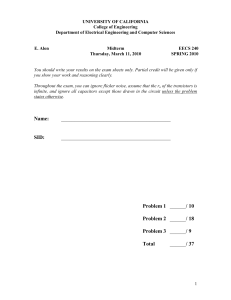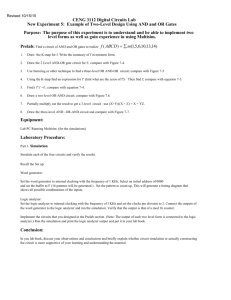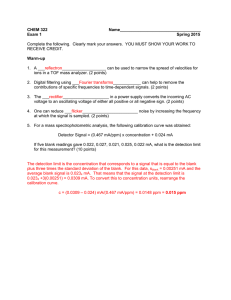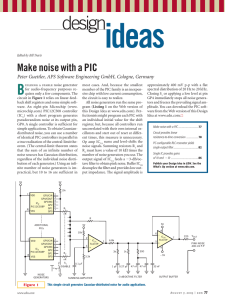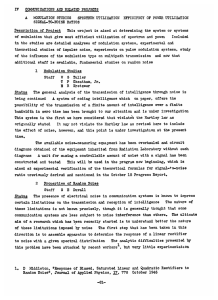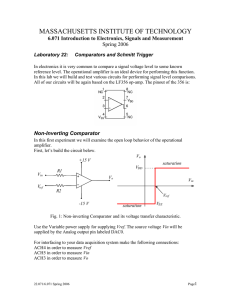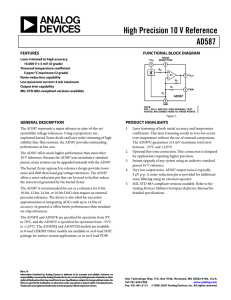CHEM 322 Name___________________________________ Exam
advertisement
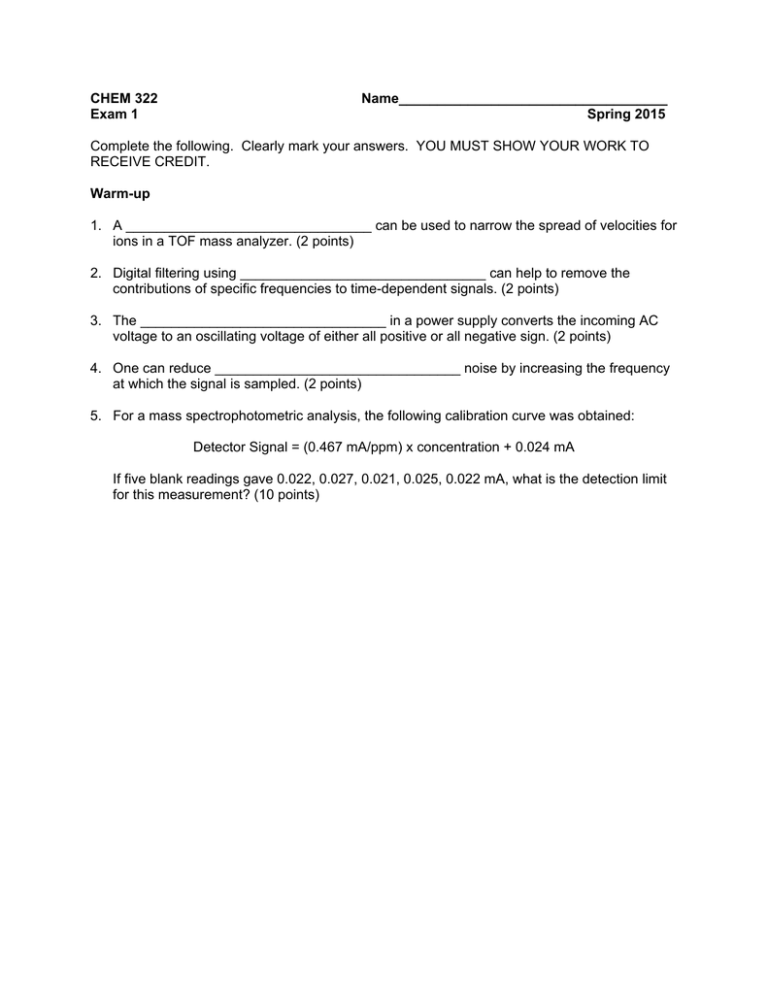
CHEM 322 Exam 1 Name___________________________________ Spring 2015 Complete the following. Clearly mark your answers. YOU MUST SHOW YOUR WORK TO RECEIVE CREDIT. Warm-up 1. A ________________________________ can be used to narrow the spread of velocities for ions in a TOF mass analyzer. (2 points) 2. Digital filtering using ________________________________ can help to remove the contributions of specific frequencies to time-dependent signals. (2 points) 3. The ________________________________ in a power supply converts the incoming AC voltage to an oscillating voltage of either all positive or all negative sign. (2 points) 4. One can reduce ________________________________ noise by increasing the frequency at which the signal is sampled. (2 points) 5. For a mass spectrophotometric analysis, the following calibration curve was obtained: Detector Signal = (0.467 mA/ppm) x concentration + 0.024 mA If five blank readings gave 0.022, 0.027, 0.021, 0.025, 0.022 mA, what is the detection limit for this measurement? (10 points) Electronics: Complete TWO of the problems 6-8. Clearly indicate which problem is not to be graded. Show all work for calculations. (12 pts each) 6. Consider the following circuit. If the current through R1 is 9.24 A and the current through R2 is 3.69 A, what is the value of R3? What is the power that is dissipated by R1? What is the potential difference across R4? R1 15.0 V R2 R1 = 200 kΩ R2= 400 kΩ R3 = ? R4 = 1 MΩ R3 R4 7. Design a circuit for calculating the average value of two input voltages multiplied by 500. Verify the output of your circuit with a calculation. 8. Consider the two circuits below. Both circuits produce similar output. How is vout related to vin for each circuit? What are the benefits of using circuit B compared to circuit A? Circuit A Circuit B vin vin - vout + vout A/D Conversion, Signals and Noise: Complete TWO of the problems 9-11. Clearly indicate which problem is not to be graded. Show all work for calculations. (12 pts each) 9. White noise corresponds to extraneous signals whose intensity does not depend on frequency. Two of the types of noise we’ve discussed can be classified as white noise. Name and briefly describe the physical phenomena that give rise to these two types of noise. How do we minimize their contribution to a measured signal? 10. You have been assigned the task of interfacing a liquid chromatograph to a computer-based data acquisition system. You have an 8-bit ADC with a 10 V range to accomplish this task. a. Because of the design of your LC detector, the maximum output voltage of the detector is 500 mV, with chromatographic peaks typically being a few tens of mV in size. Clearly describe the potential problems using your ADC system to monitor this signal. b. Design an op-amp circuit to help address the primary problems you discussed in part a. 11. Below is an example chromatogram for the system described above. Each run consumes your sample and takes about 15 minutes to complete. The data below is an example of the results of one of your separations. You are unhappy with the signal to noise ratio of your data. Estimate the S/N ratio for the first peak and describe two approaches that are appropriate to this experiment that you might take to improve S/N for this application. Note any potential problems with these approaches. You do not need to have a solution to problem 10 to complete this problem. Mass Spectrometry: Complete problem 12 (12 pts) 12. Draw and label a block diagram of a generic mass spectrometry instrument. Include all major components from sample introduction to output. How, if at all, do the components in your diagram influence the resolution and sensitivity of the instrument? Complete TWO of the problems 13-15. Clearly indicate which problem is not to be graded. Show all work for calculations. (12 pts each) 13. In simplest terms, most types of mass analyzers operate by adjusting experimental conditions to allow ions of only a small range on m/z to have a “stable” path from the inlet to the outlet of the mass analyzer. Briefly describe how either a quadrupole mass filter or a dual sector mass analyzer accomplishes this. Include in your description how a mass spectrum is “scanned” in each device 14. Consider the analysis of a relatively small organic molecule like epinephrine (C9H13NO3, molar mass 183.20 g/mol). Assuming you use the same mass analyzer and detector, how would mass spectra of epinephrine from electron impact, chemical ionization and ICP sources differ? What aspects of the sources lead to these differences? 15. Describe the similarities and differences between quadrupole ion trap and Fourier transform ICR mass spectrometers. Include a description of how a mass spectrum is collected for each instrument. Possibly Useful Information dQ dV IC dt dt P = IV = I2R V= IR vo = A(v+ - v-) v rms 4kTR f 001 + 001 = 010 f 1 3t r irms 2ief Sm Sbl ks bl RT 2d 2N A P FM Bzev 5 cm mtorr mv 2 Fc r cm Sm Sbl m m B 2r 2 e Fc z 2V k = 1.38 x 10-23 JK-1
